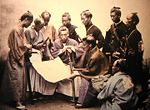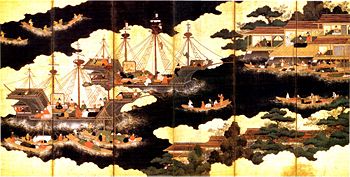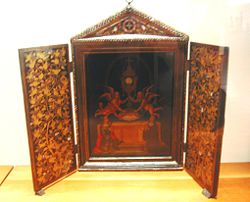Muromachi period
 History of Japan |
|---|
|
|
|
Glossary |
The Muromachi period (Japanese: 室町時代, Muromachi-jidai, also known as the Muromachi era, the Muromachi bakufu, the Ashikaga era, the Ashikaga period, or the Ashikaga bakufu) is a division of Japanese history running from approximately 1336 to 1573. The period marks the governance of the Muromachi shogunate, also as the Ashikaga shogunate, which was officially established in 1336 by the first Muromachi shogun Ashikaga Takauji (足利 尊氏). The period ended in 1573 when the 15th and last shogun Ashikaga Yoshiaki (足利 義昭) was driven out of the capital in Kyoto by Oda Nobunaga (織田 信長).
The early years of 1336 to 1392 of the Muromachi period is also known as the Nanboku-chō or Northern and Southern Court period (南北朝時代 Nanbokuchō-jidai). The later years of 1467 to the end of the Muromachi period is also known as the Sengoku period (戦国時代 Sengoku-jidai).
Ashikaga Bakufu
The ensuing period of Ashikaga rule (1336–1573) was called Muromachi for the district of Kyoto in which its headquarters were located after the third shogun Ashikaga Yoshimitsu (足利 義満) established his residence there in 1378. What distinguished the Ashikaga bakufu (幕府) from that of Kamakura was that, whereas Kamakura had existed in equilibrium with the Kyōto court, Ashikaga took over the remnants of the imperial government. Nevertheless, the Ashikaga bakufu was not as strong as the Kamakura had been and was greatly preoccupied with civil war. Not until the rule of Ashikaga Yoshimitsu (as third shogun, 1368–94, and chancellor, 1394–1408) did a semblance of order emerge.
Yoshimitsu allowed the constables, who had had limited powers during the Kamakura period, to become strong regional rulers, later called daimyo (大名). In time, a balance of power evolved between the shogun and the daimyo; the three most prominent daimyo families rotated as deputies to the shogun at Kyoto. Yoshimitsu was finally successful in reunifying the Northern Court and the Southern Court in 1392, but, despite his promise of greater balance between the imperial lines, the Northern Court maintained control over the throne thereafter. The line of shoguns gradually weakened after Yoshimitsu and increasingly lost power to the daimyo and other regional strongmen. The shogun's decisions about imperial succession became meaningless, and the daimyo backed their own candidates. In time, the Ashikaga family had its own succession problems, resulting finally in the Ōnin War (応仁の乱 Ōnin no Ran, 1467–1477), which left Kyoto devastated and effectively ended the national authority of the bakufu. The power vacuum that ensued launched a century of anarchy (see Provincial Wars and Foreign Contacts).
Economic and cultural developments
Contact with Ming Dynasty (明, 1368-1644) China was renewed during the Muromachi period after the Chinese sought support in suppressing Japanese pirates in coastal areas of China. Japanese pirates of this era and region were referred to as 倭寇, wokou, by the Chinese (Japanese wakō). Wanting to improve relations with China and to rid Japan of the wokou threat, Yoshimitsu accepted a relationship with the Chinese that was to last for half a century. In 1401 he restarted the tribute system, describing himself in a letter to the Chinese Emperor as "Your subject, the King of Japan". Japanese wood, sulphur, copper ore, swords, and folding fans were traded for Chinese silk, porcelain, books, and coins, in what the Chinese considered tribute but the Japanese saw as profitable trade.
During the time of the Ashikaga bakufu, a new national culture, called Muromachi culture, emerged from the bakufu headquarters in Kyoto to reach all levels of society. Zen (禅) Buddhism played a large role in spreading not only religious but also artistic influences, especially those derived from painting of the Chinese Song (960-1279), Yuan, and Ming dynasties. The proximity of the imperial court to the bakufu resulted in a commingling of imperial family members, courtiers, daimyo, samurai, and Zen priests. Art of all kinds—architecture, literature, Noh (能) drama, comedy, poetry, the tea ceremony, landscape gardening, and flower arranging—all flourished during Muromachi times.
Shintoism
There also was renewed interest in Shinto (神道), which had quietly coexisted with Buddhism (仏教 Bukkyo) during the centuries of the latter's predominance. In fact, Shinto, which lacked its own scriptures and had few prayers, as a result of syncretic practices begun in the Nara period, had widely adopted Shingon Buddhist rituals. Between the eighth and fourteenth centuries, Shintoism was nearly totally absorbed by Buddhism, becoming known as Ryōbu Shinto (Dual Shinto). The Mongol invasions in the late thirteenth century, however, evoked a national consciousness of the role of the kamikaze in defeating the enemy. Less than fifty years later (1339-43), Kitabatake Chikafusa (北畠 親房, 1293-1354), the chief commander of the Southern Court forces, wrote the Jinnōshōtōki (神皇正統記, 'Chronicle of the Direct Descent of the Divine Sovereigns'). This chronicle emphasized the importance of maintaining the divine descent of the imperial line from Amaterasu to the current emperor, a condition that gave Japan a special national polity (kokutai). Besides reinforcing the concept of the emperor as a deity, the Jinnōshōtōki provided a Shinto view of history, which stressed the divine nature of all Japanese and the country's spiritual supremacy over China and India. As a result, a change gradually occurred in the balance between the dual Buddhist–Shinto religious practice. Between the fourteenth and seventeenth centuries, Shinto reemerged as the primary belief system, developed its own philosophy and scripture (based on Confucian and Buddhist canons), and became a powerful nationalistic force.
Provincial wars and foreign contacts
The Ōnin War (応仁の乱 Ōnin no Ran, 1467–1477) led to serious political fragmentation and obliteration of domains: a great struggle for land and power ensued among bushi chieftains until the mid-sixteenth century. Peasants rose against their landlords and samurai against their overlords as central control virtually disappeared. The imperial house was left impoverished, and the bakufu was controlled by contending chieftains in Kyoto. The provincial domains that emerged after the Ōnin War were smaller and easier to control. Many new small daimyo (大名) arose from among the samurai who had overthrown their great overlords. Border defenses were improved, and well fortified castle towns were built to protect the newly opened domains, for which land surveys were made, roads built, and mines opened. New house laws provided practical means of administration, stressing duties and rules of behavior. Emphasis was put on success in war, estate management, and finance. Threatening alliances were guarded against through strict marriage rules. Aristocratic society was overwhelmingly military in character. The rest of society was controlled in a system of vassalage. The shoen were obliterated, and court nobles and absentee landlords were dispossessed. The new daimyo directly controlled the land, keeping the peasantry in permanent serfdom in exchange for protection.
Economic effect of wars between states
Most wars of the period were short and localized, although they occurred throughout Japan. By 1500 the entire country was engulfed in civil wars. Rather than disrupting the local economies, however, the frequent movement of armies stimulated the growth of transportation and communications, which in turn provided additional revenues from customs and tolls. To avoid such fees, commerce shifted to the central region, which no daimyo had been able to control, and to the Inland Sea. Economic developments and the desire to protect trade achievements brought about the establishment of merchant and artisan guilds.
Western influence
By the end of the Muromachi period, the first Europeans had arrived. The Portuguese landed in southern Kyūshū (九州) in 1543 and within two years were making regular port calls, initiated the century-long Nanban trade period. The Spanish arrived in 1587, followed by the Dutch in 1609. The Japanese began to attempt studies of European civilization in depth, and new opportunities were presented for the economy, along with serious political challenges. European firearms, fabrics, glassware, clocks, tobacco, and other Western innovations were traded for Japanese gold and silver. Significant wealth was accumulated through trade, and lesser daimyo, especially in Kyūshū, greatly increased their power. Provincial wars became more deadly with the introduction of firearms, such as muskets and cannons, and greater use of infantry.
Christianity
Christianity had an impact on Japan, largely through the efforts of the Jesuits, led first by Saint Francis Xavier (1506–1552), who arrived in Kagoshima in southern Kyūshū in 1549. Both daimyo and merchants seeking better trade arrangements as well as peasants were among the converts. By 1560 Kyoto had become another major area of missionary activity in Japan. In 1568 the port of Nagasaki, in northwestern Kyūshū, was established by a Christian daimyo and was turned over to Jesuit administration in 1579. By 1582 there were as many as 150,000 converts (two per cent of the population) and 200 churches. But bakufu tolerance for this alien influence diminished as the country became more unified and openness decreased. Proscriptions against Christianity began in 1587 and outright persecutions in 1597. Although foreign trade was still encouraged, it was closely regulated, and by 1640 the exclusion and suppression of Christianity had become national policy (see Tokugawa Period, 1600–1867, this ch.; Religious and Philosophical Traditions, ch. 2).
Events
- 1336: Ashikaga Takauji captures Kyoto and forces Go-Daigo to move to a southern court (Yoshino, south of Kyoto)
- 1338: Ashikaga Takauji declares himself Shogun, moves his capital into the Muromachi district of Kyoto and declares the northern court
- 1392: The southern court surrenders to the Shogun Ashikaga Yoshimitsu and the empire is unified again
- 1397: Kinkaku-ji Built by Ashikaga Yoshimitsu.
- 1467: The Ōnin War is split among feudal lords (daimyo)
- 1542: Firearms are introduced by a shipwrecked Portuguese
- 1549: The Catholic missionary Francis Xavier arrives Japan
- 1568: The daimyo Oda Nobunaga enters Kyoto and ends the civil war
- 1570: The Archbishopric of Edo is established and the first Japanese Jesuits are ordained
- 1573: The daimyo Oda Nobunaga overthrows the Muromachi bakufu and extends his control over all of Japan
ReferencesISBN links support NWE through referral fees
- This article contains material from the Library of Congress Country Studies, which are United States government publications in the public domain.
- Japan
ar:فترة موروماتشي de:Muromachi-Zeit fr:Époque de Muromachi he:תקופת אשיקאגה id:Zaman Muromachi it:Periodo Muromachi ja:室町時代 ko:무로마치 시대 pl:Muromachi pt:Período Muromachi sr:Муромаћи период sv:Ashikaga th:ยุคมุโระมาจิ zh-yue:室町時代 zh:室町时代
Credits
New World Encyclopedia writers and editors rewrote and completed the Wikipedia article in accordance with New World Encyclopedia standards. This article abides by terms of the Creative Commons CC-by-sa 3.0 License (CC-by-sa), which may be used and disseminated with proper attribution. Credit is due under the terms of this license that can reference both the New World Encyclopedia contributors and the selfless volunteer contributors of the Wikimedia Foundation. To cite this article click here for a list of acceptable citing formats.The history of earlier contributions by wikipedians is accessible to researchers here:
The history of this article since it was imported to New World Encyclopedia:
Note: Some restrictions may apply to use of individual images which are separately licensed.

